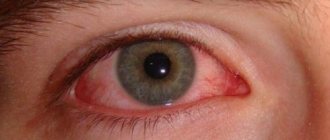Irifrin BK (tb.-drops .2.5% 0.4ml No. 15)
A country
India
Country of manufacture may vary depending on the batch of goods. Please check with the operator for detailed information when confirming your order.
Active substance
Phenylephrine
Compound
Active ingredient: phenylephrine hydrochloride - 25 mg.
pharmachologic effect
Pharmacodynamics. Phenylephrine is a sympathomimetic. Has pronounced alpha-adrenergic activity. When applied topically in ophthalmology, it causes dilation of the pupil, improves the outflow of intraocular fluid and constricts the vessels of the conjunctiva. Phenylephrine has a pronounced stimulating effect on postsynaptic alpha-adrenergic receptors, but has a very weak effect on beta-adrenergic receptors of the heart. The drug has a vasoconstrictor effect similar to that of norepinephrine (norepinephrine), while it has virtually no chronotropic and inotropic effects on the heart. The vasopressor effect of phenylephrine is weaker than that of norepinephrine, but is longer lasting. Causes vasoconstriction 30-90 seconds after instillation, duration 2-6 hours. After instillation, phenylephrine contracts the pupillary dilator and smooth muscle of the conjunctival arterioles, thereby causing pupillary dilation. Mydriasis occurs within 10-60 minutes after a single instillation. Continues after injecting a 2.5% solution and persists for 2 hours. Mydriasis caused by phenylephrine is not accompanied by cycloplegia. Pharmacokinetics: Phenylephrine easily penetrates into the eye tissue, peak plasma concentration occurs 10-20 minutes after topical application. Phenylephrine is excreted unchanged by the kidneys (Indications for use: Iridocyclitis (to prevent the occurrence of posterior synechiae and reduce exudation from the iris). Pupil dilation during ophthalmoscopy and other diagnostic procedures necessary to monitor the condition of the posterior segment of the eye, during laser interventions on the fundus and vitreoretinal surgery. Conducting a provocative test in patients with a narrow profile of the anterior chamber angle and suspected angle-closure glaucoma. Differential diagnosis of superficial and deep injection of the eyeball. “Red eye” syndrome (to reduce hyperemia and irritation of the mucous membrane of the eye). Prevention of asthenopia and spasm of accommodation in patients with high visual load. Treatment of false myopia (spasm of accommodation) and prevention of progression of true myopia in patients with high visual load.
Mode of application
When performing ophthalmoscopy, single instillations of a 2.5% solution of the drug are used. As a rule, to create mydriasis, it is enough to introduce 1 drop of a 2.5% solution of the drug into the conjunctival sac. Maximum mydriasis is achieved after 15-30 minutes and remains at a sufficient level for 1-3 hours. If it is necessary to maintain mydriasis for a long time, the drug can be re-instilled after 1 hour. For diagnostic procedures: as a provocative test in patients with a narrow anterior chamber angle profile and suspected angle-closure glaucoma, 1 drop of the drug is instilled once. If the difference between the values of intraocular pressure before instillation of the drug and after dilation of the pupil is from 3 to 5 mm Hg. Art., then the provocative test is considered positive; for differential diagnosis of the type of injection of the eyeball, 1 drop of the drug is instilled once: if 5 minutes after instillation there is a narrowing of the vessels of the eyeball, then the injection is classified as superficial; if redness of the eye persists, it is necessary to carefully examine the patient for the presence of iridocyclitis or scleritis, as this indicates expansion of deeper vessels. For iridocyclitis, to prevent the development and rupture of already formed posterior synechiae and to reduce exudation into the anterior chamber of the eye, 1 drop of the drug is instilled into the conjunctival sac of the diseased eye 2-3 times a day 5 -10 days depending on the severity of the disease. For schoolchildren with mild myopia, to prevent spasm of accommodation during periods of high visual load, 1 drop of the drug is instilled in the evening before bed, for progressive moderate myopia 3 times a week in the evening before bed, for emmetropia - in the daytime time depending on load. For hypermetropia with a tendency to spasm of accommodation under high visual load, the drug is instilled in the evening in combination with a 1% solution of cyclopentolate. With normal visual stress, instill the drug 3 times a week in the evening before bedtime. When treating false and true myopia, 1 drop of the drug is instilled in the evening before bedtime 2-3 times a week for a month.
Interaction
The mydriatic effect of phenylephrine is enhanced when used in combination with topical atropine. Due to the increased vasopressor effect, the development of tachycardia is possible. The use of the drug within 21 days after the patient stops taking monoamine oxidase inhibitors and tricyclic antidepressants should be carried out with caution, since in this case there is the possibility of an uncontrolled rise in blood pressure. The vasopressor effect of adrenergic agents can also be potentiated by combined use with tricyclic antidepressants, beta-blockers, reserpine, guanethidine, methyldopa and m-anticholinergics. The drug can potentiate the depression of cardiovascular activity during inhalation anesthesia as a result of increased sensitivity of the myocardium to sympathomimetics and the occurrence of ventricular fibrillation. Use together with other sympathomimetics can increase cardiovascular effects of phenylephrine. The use of phenylephrine may weaken concomitant antihypertensive therapy and lead to an increase in blood pressure and tachycardia. Pre-administration of local anesthetics may increase systemic absorption and prolong mydriasis.
Side effect
Local. Conjunctivitis, keratitis, periorbital edema, eye pain, burning during instillation, lacrimation, blurred vision, irritation, discomfort, increased intraocular pressure, blocking the anterior chamber angle (with a narrowing of the angle), allergic reactions, reactive hyperemia. Phenylephrine may cause reactive miosis the day after use. Repeated instillations of the drug at this time may produce less pronounced mydriasis than the day before. This effect is more common in elderly patients. Due to the significant contraction of the pupil dilator under the influence of phenylephrine, 30-45 minutes after instillation, pigment particles from the pigment leaf of the iris may be detected in the moisture of the anterior chamber of the eye. Suspension in the chamber fluid must be differentiated from manifestations of anterior uveitis or from the ingress of blood cells into the fluid of the anterior chamber. Systemic. Contact dermatitis. From the cardiovascular system. Rapid heartbeat, tachycardia, arrhythmia, increased blood pressure, ventricular arrhythmia, reflex bradycardia, coronary artery occlusion, pulmonary embolism.
Contraindications
Hypersensitivity to the components of the drug. Narrow-angle or closed-angle glaucoma. Arterial hypertension in combination with ischemic heart disease, aortic aneurysm, atrioventricular block I-III degree, arrhythmia. Tachycardia. History of type I diabetes mellitus. Constant use of monoamine oxidase inhibitors, tricyclic antidepressants, antihypertensive drugs. Additional dilation of the pupil during surgical operations in patients with a violation of the integrity of the eyeball, as well as in cases of impaired tear production. Reduced body weight in newborns. Hyperthyroidism. Hepatic porphyria. Congenital deficiency of glucose-6-phosphate dehydrogenase. Breastfeeding period.
Overdose
Symptoms of overdose include restlessness, nervousness, dizziness, sweating, vomiting, rapid heartbeat, and weak or shallow breathing. If systemic effects of phenylephrine occur, side effects can be controlled by using alpha-blockers, for example, 5 to 10 mg of phentolamine intravenously. If necessary, the injection can be repeated.
special instructions
With caution. In patients with type II diabetes mellitus, there is an increased risk of increased blood pressure. In elderly patients, there is an increased risk of reactive miosis. Exceeding the recommended dose of a 2.5% solution in patients with injuries, diseases of the eye or its appendages, in the postoperative period, or with reduced tear production may lead to increased absorption of phenylephrine and the development of systemic side effects. Due to the fact that it causes hypoxia of the conjunctiva - in patients with sickle cell anemia, when wearing contact lenses, after surgery (reduced healing). With cerebral atherosclerosis, long-term bronchial asthma. Pregnancy and lactation. In animals in late pregnancy, phenylephrine caused fetal growth retardation and stimulated early onset of labor. Effect of the drug in pregnant women women have not been sufficiently studied, so the drug should be used in this category of patients only if the expected benefit to the mother outweighs the risk of developing possible side effects to the fetus. If the drug is prescribed during lactation, breastfeeding should be stopped.
Dispensing conditions in pharmacies
On prescription
Irifrin BK eye drops 2.5% 0.4 ml, 15 tubes - droppers
Registration Certificate Holder
SENTISS PHARMA (India)
Dosage form
Medicine - Irifrin® BK (Irifrin BK)
Description
Eye drops
(without preservative) in the form of a clear solution from colorless to light yellow.
1 ml
phenylephrine hydrochloride 25 mg
Excipients
: disodium edetate - 1 mg, sodium metabisulfite - 2 mg, citric acid - 1.16 mg, sodium citrate dihydrate - qs, hypromellose - 3 mg, water for injection - up to 1 ml.
0.4 ml - disposable dropper tubes (5) - laminated paper bags (3) - cardboard packs.
Indications
Orally and locally: to reduce swelling of the mucous membrane of the nasopharynx and conjunctiva during colds and allergic diseases (mainly as part of combination drugs).
Parenteral: to increase blood pressure during collapse and arterial hypotension due to decreased vascular tone.
Contraindications for use
Arterial hypertension, severe atherosclerosis, tendency to spasms of coronary vessels, increased sensitivity to phenylephrine.
pharmachologic effect
Adrenomimetic. It has a direct stimulating effect mainly on α-adrenergic receptors.
When used systemically, it causes constriction of arterioles, increases peripheral vascular resistance and blood pressure. Cardiac output does not change or decreases, which is associated with reflex bradycardia (increased vagal tone) in response to arterial hypertension. Phenylephrine does not increase blood pressure as sharply as norepinephrine and epinephrine, but it acts longer. This is apparently due to the fact that phenylephrine is more stable and is not destroyed by COMT.
When applied topically, phenylephrine has a pronounced vasoconstrictor effect, causes mydriasis, and can lower intraocular pressure in open-angle glaucoma.
In average therapeutic doses it has virtually no effect on the central nervous system.
Drug interactions
When using phenylephrine against the background of general anesthesia induced by halothane or cyclopropane, ventricular fibrillation may develop.
When used simultaneously with MAO inhibitors, a potentiation of the effects of phenylephrine is observed (including when applied topically).
Phenothiazines, alpha-blockers (phentolamine), furosemide and other diuretics reduce the vasoconstrictor effect of phenylephrine.
Guanethidine enhances the mydriatic effect of phenylephrine (with systemic absorption).
Oxytocin, ergot alkaloids, tricyclic antidepressants, furazolidone, procarbazine, selegiline, sympathomimetics increase the pressor effect, and the latter also increase arrhythmogenicity.
When used simultaneously, beta-blockers reduce pacemaker activity; against the background of reserpine, arterial hypertension is possible (due to depletion of catecholamine reserves in adrenergic neurons, sensitivity to sympathomimetics increases).
Dosage regimen
When taken orally and topically, the dose depends on the indications and the dosage form used.
When administered subcutaneously or intramuscularly, a single dose is 2-5 mg, then, if necessary, 1-10 mg. When administered intravenously as a stream (slowly), the single dose is 100-500 mcg. With intravenous infusion, the initial rate is 180 mcg/min, then, depending on the effect, it is reduced to 30-60 mcg/min.
Maximum doses:
for adults, when taken orally, a single dose is 30 mg, a daily dose is 150 mg; subcutaneous or intramuscular single dose - 10 mg, daily dose - 50 mg; with intravenous administration, a single dose is 5 mg, daily - 25 mg.
Side effect
From the cardiovascular system:
an undesirable prolonged increase in blood pressure, tachycardia or reflex bradycardia is possible.
Local reactions:
Possibly irritating to mucous membranes.
special instructions
Phenylephrine should be avoided in patients with severe hyperthyroidism.
Use with caution in case of ischemic heart disease.
When applied topically after absorption through the mucous membrane, phenylephrine can cause systemic effects. Therefore, the use of phenylephrine 10% eye drops should be avoided in infants and elderly patients.
Use during pregnancy and breastfeeding
Restrictions during pregnancy - Contraindicated. Restrictions when breastfeeding - Contraindicated.
Adequate and strictly controlled clinical studies of the safety of phenylephrine during pregnancy and lactation have not been conducted.
Use in elderly patients
Restrictions for elderly patients - Contraindicated.
When applied topically after absorption through the mucous membrane, phenylephrine can cause systemic effects. Therefore, the use of phenylephrine 10% eye drops should be avoided in elderly patients.
Use in children
Restrictions for children - Contraindicated.
When applied topically after absorption through the mucous membrane, phenylephrine can cause systemic effects. Therefore, the use of phenylephrine 10% eye drops should be avoided in infants.


